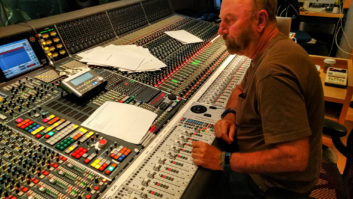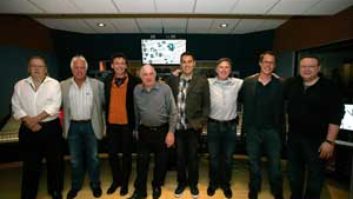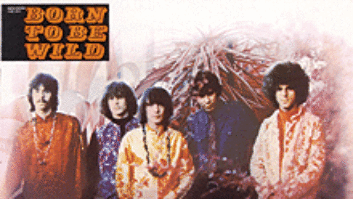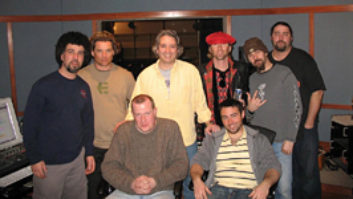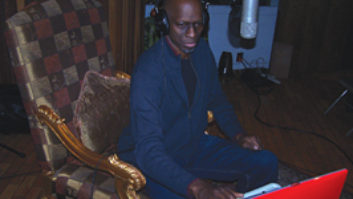Steve Cropper’s guitar signature is all over the soundtrack of American pop music culture, from the unforgettable opening bars of Sam & Dave’s “Soul Man” to tracks by Eddie Floyd, Otis Redding, Jerry Lee Lewis, Aretha Franklin, Rod Stewart, Etta James, John Lennon, and two of the greatest instrumental bands ever to make it to vinyl, The Mar-Keys and Booker T. & The MGs, both of which he helped start. He’s had stints as a musician, engineer, producer, studio owner, composer, musical director and businessman. Since his teenage years in Memphis, Cropper has played all of his roles to the hilt. Now just past his 60th birthday, he remains one of music’s incurable optimists: You can see it in his eyes as they light up at the sight of his 15-month-old son toddling into his office off Nashville’s Music Row. In fact, Cropper — burly, ponytailed and unfailingly friendly — looks closer to 40, and he plays as well as he ever did. At a birthday bash/charity ball in a Nashville club, which was also the occasion of the MGs’ 40th anniversary, Cropper was joined onstage by his old bandmates Booker T. and Donald “Duck” Dunn, and the guitarist simply did not miss a lick and, as always, made it all look effortless. (The show was capped by a presentation to Cropper, from ASCAP, citing his song “Dock of the Bay,” co-written with Otis Redding, as the second most-played song in the organization’s history.)
You’re usually associated with Memphis, but you’re not from there, are you? Was yours a musical family?
I was born in Missouri. We didn’t move to Memphis till I was 10 years old. My dad was a farmer, then a machinist in the Navy and then a policeman. My mom was a schoolteacher. Neither of them were musicians. I grew up in the Church of Christ, which was musically very restrictive — you couldn’t even play a tambourine during services. The only singing was a cappella, but it was the first time I heard gospel music. I had been raised on country and western in Missouri. But gospel was great. And I had a brother-in-law who had a guitar, an old Gibson, and I remember touching the strings and loving the vibration.
Why did Memphis become a major recording center? Nashville had the Opry and clear-channel WSM. What did Memphis have going for it?
Even in the old days, the influx of southern blues and jazz all passed through Memphis on its way to St. Louis and Chicago. Memphis is in a very lucky position on the map because of being on the [Mississippi] river; you got Tennessee, Mississippi, Arkansas, Missouri, Kentucky [nearby]. Everything just gravitated to Memphis for years.
Your first recording work was with Jim Stewart, who founded Stax Records in his garage.
Jim had a studio in his garage. First, he and Estelle Axton had Satellite Records in Brunswick, Tennessee, near Memphis. I had a band, the Royal Spades [featuring bassist Donald Dunn, drummer Terry Johnson and sax player Don Nix, which would soon become The Mar-Keys], and this guy Charles Axton, a sax player, came to us and wanted to join. We kinda brushed him off till he mentioned that his uncle owned a recording studio. That changed things. Jim wanted a bigger studio and Estelle wanted a record shop, so they moved to Memphis and started the store and recording studio on McLemore Avenue, which Mrs. Axton borrowed on her house to finance. That’s where The Mar-Keys would play — they would open the studios on Sunday to let us rehearse — and we became Jim’s house band. One day, Jim recorded Rufus Thomas’ daughter, Carla, and Chips Moman heard it and flipped out. So he produced the duet with Rufus “Cause I Love You,” and that was the first hit record I played on, and Booker T. played on it, too. [The record also won over Atlantic Records president Jerry Wexler, who optioned distribution of Stax’s releases for the next five years.]
The McLemore Avenue studio opened in 1960. What were the studio and its technology like?
It was an old movie theater. We had two Ampex 4-channel mixers strapped together for eight inputs. The last one was dedicated to an echo return, from a microphone in the bathroom. Me and some of the other bandmembers helped pull the seats out and built baffles. The control room was up on the stage with a sloping ceiling — it was about 13½ feet high at one end and went to 23 feet at the other. The studio had an Ampex 350 mono deck, and that was the one we recorded “Green Onions” and “Midnight Hour” on. Later, the studio moved up to a Scully 2-track. Tom Dowd came down from New York a few times to record and brought Phil Ely, who was the chief engineer for Atlantic Records, and they wired the left side of the mixer directly to the Scully to make stereo records. And the way it was set up, the music went to one side and the echo went to the other side; there was no middle pot. We knew it was crude, but most of the hits to that point had been in mono, and we all thought that stereo wouldn’t amount to much, anyway. [Noted Memphis producer] Willie Mitchell refused to mix in stereo.
The thing about those days was that you could change hats on a daily basis — one day you’re the musician, the next you’re the producer, the next you’re engineering. How did all of those roles fall together for you?
Well, for starters, the funniest thing was that I started getting calls to do sessions at Stax and Sun Studios as a guitarist, because Scotty Moore and Chips Moman wanted to do their own engineering. I never thought I was that good of a guitarist compared to Scotty, though I knew I could hold my own. But he wanted to engineer, so he would call me to play guitar. Later in life, I would do the same thing.
I mixed a lot of records then. I loved being an engineer. I still love to mix. I’m still very much a hands-on board player. I play the faders like a piano, which is how we did it back then. I think I could have gone on to be an engineer full time, except that there was more demand for my playing. But the love of working the board never leaves you. I wasn’t schooled on it, but back then, no one was. I learned about miking [guitar] amplifiers from Ron Capone, who engineered at a jingle company in Memphis. He had learned microphone placement on classical sessions, so that was the most formal training I ever got. He also taught me how to listen to a room. At Stax, the microphones never moved from day to day. It was like that for 20 years. The same singers sang on the same microphone, so it was easy to remember where to put the mics. Most studios in Memphis had a house set of drums; the drummers just brought their own sticks. I remember a time when Al Jackson got called to a session someplace, and they didn’t have a drum kit. It was like, “Are you kidding? Every place has its own drums!”
EQ was just how you positioned the microphone. A typical session was like the one we did for “Green Onions”: one microphone on the organ, one on the guitar amp, one on the bass and one each on the kick and the snare. We’d put that microphone up in between the snare and the hat. We didn’t use an overhead microphone on the drums. I didn’t see that technique till I moved out to Los Angeles.
When you and Duck Dunn and the rest of the MGs were the house band at Stax, were you playing sessions elsewhere regularly?
At Stax, originally, we weren’t allowed to do outside projects. I got calls I had to turn down — I got called to play for Frank Sinatra Jr. and I couldn’t do it. There was a guy, Dominic Frontiere, a big arranger for Hollywood films. I had met him in New York and he loved the work I was doing, and he said he had three movies coming up and he was swamped. He said if I could do the music tracks, he would do the sweetening. But it had become Jim’s policy that his musicians only played for him in the studio. A lot of friction developed around that. It’s one of the things that led me to own my own studio for a while. I had a place in Memphis called Trans Maximus — TMI — with a partner named Jerry Williams. I had it for about two-and-a-half years, but it didn’t really pan out. We had deals with Columbia Records, then RCA, but there was a recession in the early 1970s, and you had to wait for your royalties in the record business, so Jerry pulled the plug.
But owning your own studio and leaving Stax behind broadened your horizons. You began to get calls as a producer.
I got signed as a producer to Columbia first, then to RCA. At Columbia, Clive Davis had me do a record for Poco [the 1971 release, From the Inside]. But it was RCA that wanted me to do a record with José Feliciano, and that really changed a lot of things for me. He wanted to record in Los Angeles, in Orange County, where he lived. So I lived in a hotel across the street from Disneyland for a month while we made Memphis Menu [1972]. In doing that, I went from the really crude way we had of recording in Memphis to working with the top engineers and technologies in Los Angeles. I was moving around more, meeting more people. I was flying between Memphis and L.A., and that’s how I met people like Mike Curb and Ringo [Starr], who asked me on the plane to play on his records [Ringo, 1973; Goodnight Vienna, 1974] that Richard Perry produced. I was doing records with Phil Spector, and I worked on the John Lennon Rock & Roll record. I played on Barbi Benton’s record — she was Hugh Hefner’s girlfriend at the time, so there I was at the Playboy mansion two times. I was getting around. It was fun. I was in Los Angeles for 13 years altogether.
What eventually brought you to Nashville?
I had been doing some songwriting in Nashville. Mentor Williams and I were big friends in L.A., and when he got ready to do his demos, he wanted to use Nashville musicians, guys like Tommy Cogbill and Reggie Young, who had moved to Nashville. Nashville back in those days reminded me of how Memphis had been.
But you were able to get some of the old Memphis vibe back with the Blues Brothers. I mean, it started as a gag for John Belushi and Dan Aykroyd on Saturday Night Live, but it really did do a tremendous service by bringing the great R&B and blues songs and artists back into contemporary music culture.
It did. It all started with Briefcase Full of Blues, which was the live album. The way that came about was, [comedian] Steve Martin was going to do nine shows at the Universal Amphitheater. He was very hot at the time, in 1978. He didn’t want to do 90 minutes straight himself, so they said, “You can pick any opening act you want.” He had a connection with John and Danny from Saturday Night Live, so he called them up and said, “I want you to open.” Belushi says, “We don’t do stand-up comedy,” and Steve says, “Do whatever you want.” So John says, “We can do the Blues Brothers!” They had been doing their Jake and Elwood Blues thing as a warm-up for the audience before the show, and the audiences loved it. They wanted to work it into the show but [producer] Lorne Michaels said no. Then there came this week where the writers were working on a sketch till 10 minutes before airtime, and it just wasn’t working. They had a hole in the show, and Lorne finally said, “Do the Blues Brothers thing.” The response was amazing. People went nuts.
My connection with them was, during the summer, Lorne Michaels had given all of the cast members a camera crew to record their summer vacations. Tom Malone [trombone player, now with the Letterman band] had been on the road with Donald [Dunn] and I and suggested that we do it. He told them the records we had played on, John called up [Capricorn Records president] Phil Walden and said, “What’s with this Cropper guy? Did he really play on all that stuff?” So I got the call. I was mixing a Robben Ford record at the time, and Robben was good about saying go for it. We did the show, and the record sold four-and-a-half million copies.
What kind of input did you have into the development of the Blues Brothers’ music?
I truly respected their love for the blues, but they were doing stuff that no one had ever heard of, including me, so that’s pretty obscure stuff. Duck says to me, “These guys are off the wall; you have to talk to them.” I was thinking along more commercial lines, so I suggested that they move around a little more onstage, a little more like Sam & Dave did. That led to them putting “Soul Man” in the act. The fun part was that Duck and I had played on that record. We were getting to relive that part of our career again. But my favorite moment of the whole thing was when John suggested that I get a hold of all the blues records I could so I could research the music.
You’ve produced records for Robben Ford, Jeff Beck, Albert King, José Feliciano. What’s the dynamic when a guitar player produces other guitar players?
Establishing trust. Letting them know that I’m one of them, that I’ve been there, that there’s no competition between us. It helps to respect each other, too. Like José. He’s one of the finest guitar players ever. He plays a gut-stringed guitar, which I mike pretty much like any standard acoustic guitar. The thing to keep in mind is that in Flamenco-style playing, the [picking] hand tends to spike the meters, especially José, who has these long fingernails. You have to balance the amount of limiting you put on the microphone. Also, since he’s blind, as a singer, he tends to, what we call, “eat the mic” — getting really on top of it. The way we got around that was to put a microphone right in front of him that he could work off, but put the real one about eight inches back from him. We just never told him.
Because you were brought up in such an analog environment, how do you feel about digital recording?
I like to start a session analog, but I’m not an “analog to the death” kind of guy. I believe in technology going forward. I do like to work with an engineer, but I know how to run Pro Tools, and I have a system in my own studio. But, ultimately, my ears won’t fool me. Even when I do a session on digital, we still warm it up somewhere in the process, in mastering or mixing, running the signal through some tubes somewhere. Where digital works against music is that it breaks the music down too much [in the process of sampling it]. It takes the harmonic distortion out of it.
Stax went out of business in a bankruptcy in 1976, and the masters after the 1968 deal with Wexler and Atlantic were bought by Fantasy Records. Does any of the old Memphis exist anymore?
Not really. The McLemore Avenue building was torn down, and the contents were all auctioned off. But there is a development in progress to create a Stax museum, which would re-create the old studio, too. And I’m playing a role in that that I’m really looking forward to.
Dan Daley is Mix‘s East Coast editor.

